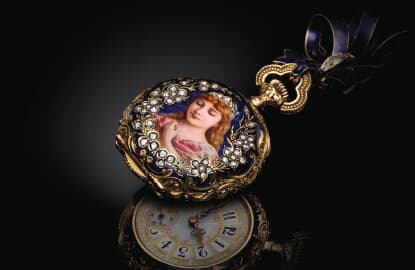
When a horologist hears the name Jaeger-LeCoultre, not only will an eyebrow lift but heart-pounding elation will also set in. It should come as no surprise as the famous Swiss brand is renowned for its flawless timepieces. While watchmaking is an art itself that includes the creation of mechanical marvels like tourbillons and perpetual calendars, Jaeger-LeCoultre marries it with delicate craftsmanship like the art of engraving, hand enamelling and gem-setting to create even more stunningly beautiful timepieces.
Recently, at The Art of Time exhibition in Pavilion Kuala Lumpur, Jaeger-LeCoultre held enamelling demonstrations and master classes by the maison’s master enameller Miklos Merczel, who has been in the industry for more than 25 years. The company is one of the few that has its own in-house enamel studio to keep this métier d’art alive.
Enamelling is an ancient art and, since the 17th century, it has gone hand in hand with watchmaking. It is also a painstaking process; imagine having to produce a portrait of the Mona Lisa on something the size of a postage stamp and using enamel to paint every stroke of colour with brushes as slender as needles? Enamel is basically glass melted together with a colorant, which typically contains metal oxide.
At the demonstrations, Merczel had to peer into a microscope to scrape off pieces of dried enamel bit by bit to form the visuals. It is an art that requires extraordinary attention to detail, masterful painting skills, the dexterity of a surgeon and loads of patience. Each layer of colour has to be baked in a kiln and cooled before proceeding to the next layer; a portrait can be fired numerous times. However, each firing involves the risk of annihilating all the work done up until that point.
There are many enamelling techniques but the most commonly used methods are champlevé and cloisonné. Champlevé is an enamelling technique in which metal is carved away and the resulting cells are filled with enamel. As for Cloisonné, the outline of the dial design is formed by first adding compartments to the metal object, either by soldering or adhering silver or gold wires or thin strips placed on their edges.
The former technique was used to produce one of Jaeger-LeCoultre’s most well-known watch decorations — a map of the Americas which decorates the face of the Master Grand Tourbillon Continents.
Some of Jaeger-LeCoultre’s finest enamel works were featured at The Art of Time exhibition, including an 1890 pocket watch, a 1949 Reverso enamelled Rama and 1900 enamelled Lépine-type pendant watch.
As it is the 80th anniversary of the Reverso this year, the enamelled Rama piece is especially meaningful to behold, seeing it was India which inspired the birth of the Reverso. The link between the Swiss house and India started in 1931 when officers of the British army stationed in India challenged Jacques-David LeCoultre to design a timepiece to resist hard knocks sustained during polo games.
This particular Reverso model depicts the Hindu deity Rama and dates all the way back to1949. One glance and you will agree the miniature artwork remains as fascinatingly fresh as ever, attesting the durability — and enduring elegance — of enamel.
The enamelling process
Preparing the painting surface
Start with a surface such as a watch case of yellow or white gold. The surface is cleaned with an ultrasonic machine and a special alcohol. Then a little hammer is used, if needed, to ensure that the surface is flat. Clean it again.
To prevent distortion, the reverse side is painted with enamel of the same colour that will be used on the front; an unpainted surface could become convex or concave during firing. A special clear liquid glue is applied on the reverse side to cover and protect the enamel. It will prevent the enamel from falling off when the surface is turned.
Turn it over and paint the case or dial with white enamel before proceeding to dry under a lamp. Then the piece is put into a kiln to fix the enamel, at 800°C for one minute. Let it cool for two minutes.
The process is repeated on both sides — enamel, dry, fix, let cool. When that is done, a third layer of enamel is applied again but only on the front side. Dry and fix the enamel in the kiln, then let it cool. Lastly, the front side is polished with emery paper.
Painting the art visual
Start drawing in enamel, first outlining in one colour and then drying it in the kiln at 200°C for two minutes. The lower heat won’t fix the colour permanently, so it can be retouched if necessary. Let it cool and start painting with different colours.
If one colour touches another, each colour must be set individually, fired in the kiln at 200°C for two minutes and let to cool. This process can be repeated as many times as required and, once the piece is satisfactory, it is fired again at 800°C for 45 seconds to fix the colours.